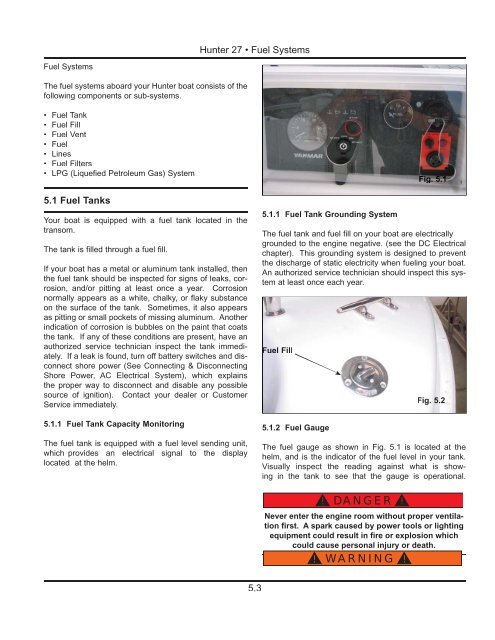27 Operator's Manual.. - Marlow-Hunter, LLC
27 Operator's Manual.. - Marlow-Hunter, LLC
27 Operator's Manual.. - Marlow-Hunter, LLC
You also want an ePaper? Increase the reach of your titles
YUMPU automatically turns print PDFs into web optimized ePapers that Google loves.
<strong>Hunter</strong> <strong>27</strong> • Fuel Systems<br />
Fuel Systems<br />
The fuel systems aboard your <strong>Hunter</strong> boat consists of the<br />
following components or sub-systems.<br />
•<br />
•<br />
•<br />
•<br />
•<br />
•<br />
•<br />
Fuel Tank<br />
Fuel Fill<br />
Fuel Vent<br />
Fuel<br />
Lines<br />
Fuel Filters<br />
LPG (Liquefied Petroleum Gas) System<br />
5.1 Fuel Tanks<br />
Your boat is equipped with a fuel tank located in the<br />
transom.<br />
The tank is filled through a fuel fill.<br />
If your boat has a metal or aluminum tank installed, then<br />
the fuel tank should be inspected for signs of leaks, corrosion,<br />
and/or pitting at least once a year. Corrosion<br />
normally appears as a white, chalky, or flaky substance<br />
on the surface of the tank. Sometimes, it also appears<br />
as pitting or small pockets of missing aluminum. Another<br />
indication of corrosion is bubbles on the paint that coats<br />
the tank. If any of these conditions are present, have an<br />
authorized service technician inspect the tank immediately.<br />
If a leak is found, turn off battery switches and disconnect<br />
shore power (See Connecting & Disconnecting<br />
Shore Power, AC Electrical System), which explains<br />
the proper way to disconnect and disable any possible<br />
source of ignition). Contact your dealer or Customer<br />
Service immediately.<br />
5.1.1 Fuel Tank Capacity Monitoring<br />
The fuel tank is equipped with a fuel level sending unit,<br />
which provides an electrical signal to the display<br />
located at the helm.<br />
5.1.1 Fuel Tank Grounding System<br />
The fuel tank and fuel fill on your boat are electrically<br />
grounded to the engine negative. (see the DC Electrical<br />
chapter). This grounding system is designed to prevent<br />
the discharge of static electricity when fueling your boat.<br />
An authorized service technician should inspect this system<br />
at least once each year.<br />
5.1.2 Fuel Gauge<br />
The fuel gauge as shown in Fig. 5.1 is located at the<br />
helm, and is the indicator of the fuel level in your tank.<br />
Visually inspect the reading against what is showing<br />
in the tank to see that the gauge is operational.<br />
! DANGER !<br />
Never enter the engine room without proper ventilation<br />
first. A spark caused by power tools or lighting<br />
equipment could result in fire or explosion which<br />
could cause personal injury or death.<br />
! WARNING !<br />
5.3

















